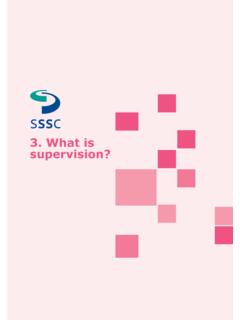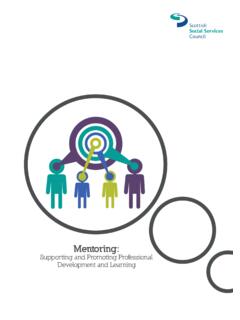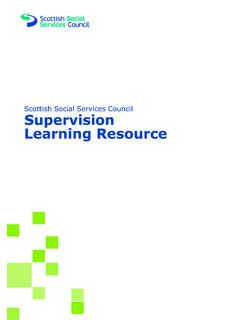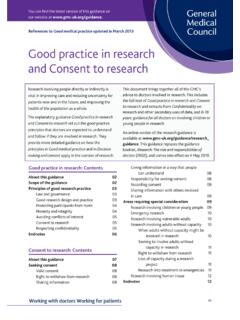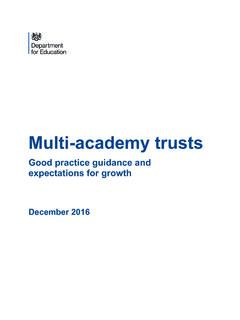Transcription of GUIDANCE FOR MENTORING IN CHILDHOOD PRACTICE
1 GUIDANCE for MENTORING in CHILDHOOD practiceGUIDANCE FOR MENTORING IN CHILDHOOD PRACTICECCUOThe Coalition of CHILDHOOD Umbrella OrganisationsGuidance for MENTORING in CHILDHOOD PRACTICE The Coalition of CHILDHOOD Umbrella Organisations 2010 Designed and published by: Communications, Care CommissionAcknowledgementThe Coalition of CHILDHOOD Umbrella Organisations (CCUO) wishes to thank the Scottish Government and parent organisations of the CCUO membership, programme learners, mentees and colleagues within the University of Edinburgh. Thanks are also due to the Scottish Social Services Council (SSSC) and the CHILDHOOD PRACTICE Development Group (CPDG) for their ongoing advice and support.
2 Also to Jennie Paul, Independent Consultant, for her help, support and advice during the early phase of the development of the for MENTORING in CHILDHOOD practiceCONTENTSF oreward Minister 1 The Coalition of CHILDHOOD Umbrella Organisations (CCUO) 21. Who is this GUIDANCE for? 32.
3 How can the guidelines be used? 7 3. Who is this GUIDANCE for? 84. What are the benefits of MENTORING ? 95. Why adopt a formal approach to MENTORING ?
4 116. Key ingredients for successful MENTORING frameworks 127. Designing a framework 138. Coordinating a MENTORING programme 149. Training, induction and raising awareness 15 10. Criteria for selecting of mentors and mentees 1711. Matching mentors and mentees 1812.
5 The MENTORING process and the relationship cycle 19 13. What is the purpose of the first meeting? 2014. Monitoring and evaluation 21 References 23 Terms we have used and what they mean 24 The MENTORING toolkitThis section contains good PRACTICE information, activities and templates which can be adapted to suit the specific requirements of individual employers and can also find good PRACTICE advice and templates by contacting the Scottish MENTORING Association, the International MENTORING Association and other toolkit 25A.
6 What makes a good mentor? 26B. Self assessment planning tool 27C. MENTORING framework template 31D. Characteristics of successful mentees 35 E. Flow chart for recruiting and selecting mentors and mentees 36F. Sample MENTORING agreement form 37G. A working model of the MENTORING process 38 GUIDANCE for MENTORING in CHILDHOOD practiceH. The relationship cycle 40I. Action planning and goal setting 42J. Action plan template 43K. Optimum conditions for effective adult learning 44L. Issues to consider when planning the meetings 45M.
7 Meeting log template 46N. Case study: mentor log, CCUO pilot 2010 47O. Monitoring progress: what to check for 51 Appendix1. CCUO Membership 52 GUIDANCE for MENTORING in CHILDHOOD practiceFOREWORD Having a confident, competent and valued workforce that can deliver excellent services for children and families in Scotland now and in the future, is essential. I want services to be dynamic, operating within learning organisations, with people who continuously develop their PRACTICE and deliver effective, early intervention to ensure improved outcomes for children.
8 This requires managers with professional skills, knowledge and understanding of working with children in these, their most formative years, and strong leadership skills. That is why we are asking all managers in day care of children services to extend their learning to SCQF level 9 in CHILDHOOD PRACTICE . I am pleased to note that many lead practitioners and managers across children s services have risen to the challenge. Some have already graduated with their BA in CHILDHOOD PRACTICE . Many more are enrolled on courses across the country, demonstrating their commitment and passion and I am immensely proud of our children s workforce.
9 We must make best use of the knowledge, skills and understanding being gained by the workforce and create a workplace that actively encourages leadership to flourish and to support people to continuously learn and develop. Effective MENTORING can maximise the success of managers embarking on CHILDHOOD PRACTICE learning. It can also support and encourage managers to lead and improve PRACTICE in their workplace. That is why the Scottish Government supported the development of this MENTORING in CHILDHOOD PRACTICE GUIDANCE . It has been created by the sector, for the sector and I am pleased that it can now be am confident this GUIDANCE will help employers and managers develop MENTORING programmes that maximise the skills of our workforce and develop services that ensure children in Scotland get the best possible start in life.
10 Adam Ingram MPMinister for Children and Young People1 GUIDANCE for MENTORING in CHILDHOOD practice2 COALITION OF CHILDHOOD UMBRELLA ORGANISATIONS Following the launch of the CHILDHOOD PRACTICE Standard (December 2007) the Scottish Social Services Council (SSSC) set up the CHILDHOOD PRACTICE Development Group (CPDG) to promote and encourage the development of CHILDHOOD PRACTICE level 9 awards and to ensure pathways to awards are flexible and accessible to learners and employers in the of the CPDG working groups draws together the breadth and range of professional expertise found in CHILDHOOD PRACTICE and includes representatives from Scotland s learning institutions, national registration, inspection and advisory agencies and voluntary.
